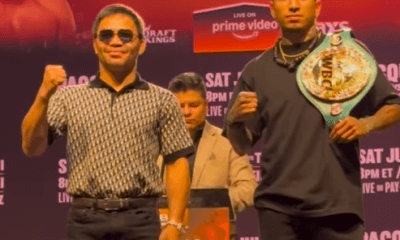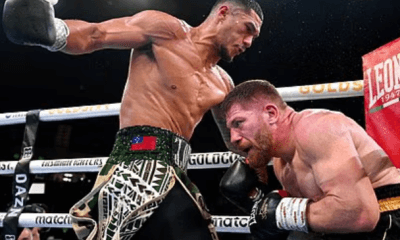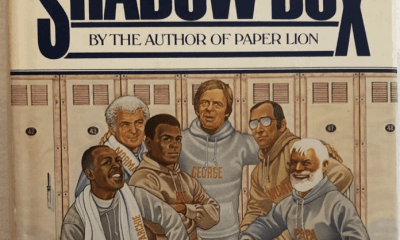Featured Articles
Countdown To Mayweather-Pacquiao: What A Win Means For Pacquiao
He’s been electrifying boxing fans for over a decade.
He’s won a world title in eight different weight divisions between 112 and 154. And in nine bouts against his three most fierce career rivals, Marco Antonio Barrera, Erik Morales and Juan Manuel Marquez, he’s compiled a 6-2-1 record. In addition to those three greats he stopped a faded Oscar De La Hoya, who was a multiple division title holder, destroyed the once beaten Miguel Cotto, who is the only Puerto Rican fighter in history to win a world title in four different weight classes. He also dominated a monster named Antonio Margarito, who was much physically bigger than he is. He defeated Shane Mosley when he was shot, but in his defense, Mosley was a three division title holder and he was able to put him down, not an easy feat. In his second to last fight he became the first to beat Timothy Bradley when he was probably the third-best welterweight in the division. That’s quite a run for a fighter who won his first professional title as a flyweight.
Those accomplishments alone pretty much guarantee Manny Pacquiao a place among the top pound for pound fighters in boxing history. On May 2nd he will fight another career rival, Floyd Mayweather 47-0 (26). Mayweather is considered by many to be the best pound for pound fighter in professional boxing. He’s won a world title in five different weight divisions and other than one fight (his first against Jose Luis Castillo who really did beat him in the ring) he hasn’t tasted defeat. Floyd loves to spew how he’s “the best ever,” something that rings hollow to many sophisticated boxing fans born before 1980. That said, Mayweather is an authentically great fighter and although I don’t consider him among the top 10-12 greatest welterweights in history, there’s really only about seven or eight on the list who he’d have absolutely no chance to beat and who would’ve beat him 10 times in 10 fights.
With Pacquiao’s overwhelming success moving up in weight over the last decade many have forgotten that Manny won his first title as a flyweight. This is 18 pounds south of where Mayweather captured his first world title as a junior lightweight. Today they both fight as welterweights with the difference being Manny has never fought at the 147 division limit; actually he’s never been over 145 fighting as a welterweight. Mayweather is the predominantly bigger framed man and he is greatly skilled. Floyd is taller, longer and physically stronger than Pacquiao. If Pacquiao were to beat Mayweather when they finally meet without much controversy attached, it would be a monumental feat. It would definitely be the most significant win scored by any fighter in over a decade, something I’m sure no one would argue. For a fighter who started as a flyweight to become unequivocally the top fighter in the welterweight division is literally off the chart.
Rating/ranking fighters in an historical context is so hard to do and it’s even more subjective than hard. Exactly where a Pacquiao win over Mayweather would place him among the all-time greats I guess mostly depends on where you see Mayweather fitting in. Manny being the first fighter to beat Mayweather would no doubt be the signature win of his stellar career and the one he’d be the most remembered for. The question is, just how high up the all-time pantheon does that elevate him? Among younger and casual fans Manny probably does better than cracking the top-15. However, I doubt that he would catapult that high in the eyes of boxing insiders and historians.
There have been three fights in the last 30 years in which an undefeated great or a champion who was perceived to be even more unbeatable than Mayweather is now lost as an overwhelming favorite. Two of the three winners are certifiable all-time greats and one has been almost forgotten.
On September 21, 1985, undefeated/undisputed light heavyweight champ Michael Spinks 27-0 won a 15-round unanimous decision over IBF heavyweight champ Larry Holmes 48-0. At the time Holmes 35, was on the decline and had some close calls in his last few fights just as Mayweather has. But Holmes weighed in at 223 pounds, that’s 48 pounds more than any fighter Spinks ever fought. The 29 year old Spinks was a 6-1 underdog and he out-boxed one of the greatest boxers in heavyweight history. After beating Holmes, Michael Spinks’ legacy exploded and deservedly so. Today he’s considered among the top five or six greatest light heavyweights in history – and beating Larry Holmes has a lot to do with that because no other light heavyweight ever scored or more significant win.
On April 6, 1987, former welterweight and junior middleweight champ Sugar Ray Leonard 33-1 won a 12-round split decision over undisputed middleweight champ Marvin Hagler 60-2-2. Leonard, 30, had one fight in five years going into the fight. Hagler, 32, had been champ for seven years and hadn’t lost a fight in 11 years before fighting Leonard – and they are thought to be hometown decisions to Philly stalwarts Bobby “Boogaloo” Watts and Willie “The Worm” Monroe. Hagler avenged both of those loses by knockout. His draw to Sugar Ray Seales is considered another hometown decision against him, and everyone who saw him fight Vito Antuofermo for the title thought he won, instead of the draw the fight was declared. A case can be made that in the ring Hagler was 66-0 going into the Leonard fight, and unlike Mayweather, he was avoided and ducked by other contenders instead of the opposite. Leonard was already considered an all-time great before he fought Hagler but beating him as a 4-1 underdog knocked his legendary status out of the park.
On May 15, 2004 WBA/WBC light heavyweight champ Antonio Tarver 21-2 TKO’d former light heavyweight/WBA heavyweight title holder Roy Jones 49-1 (the loss was by DQ to Montell Griffin the first time they met) in the second round of their rematch. Jones, 35, beat Tarver, 35, the first time they fought via a controversial decision. For their first fight Jones had to drop nearly 30 pounds to get down to light heavyweight again after beating John Ruiz for the WBA heavyweight title in his last fight. Roy was weakened by the weight loss and that seemed to hinder him against Tarver, yet he was still a 4-1 favorite for the rematch. Roy was in great shape for their grudge match. However, Tarver, after losing the first round, knocked Jones out beyond recuperation to win the titles he lost to him. Sadly, everyone forgets that if Jones retired at 34 after beating Ruiz he may have gone down among the top five pound for pound fighters in history. So it’s fair to say that Roy’s reputation of being unbeatable easily exceeds Mayweather’s today. But due to his sub-standard performances after losing to Tarver, his perception of the true great he was has been forgotten.
When Michael Spinks beat Larry Holmes, Larry was riding a 12-year undefeated streak and 21 of his 48 wins were posted in title bouts. Mayweather is unbeaten in 19 years and 24 of his 47 wins occurred in title bouts. If Pacquiao can beat Mayweather, his career should get the same injection historically that Spinks’ did.
Sugar Ray Leonard didn’t need to beat Hagler to justify his legacy, but boy did winning their fight help. Many were not only sure Marvin was going to win their fight, they thought he was going to seriously injure and hurt Ray…..yet he was never on the verge of being in trouble during the fight. Pacquiao beating Mayweather wouldn’t and shouldn’t rank near Leonard beating Hagler.
Antonio Tarver beating Roy Jones, when he did, should get more props than it does. The problem is, neither of them looked like all world fighters again after facing each other. Actually, Tarver beating Jones the way he did in their rematch is much more impressive than Pacquiao beating Mayweather, if he does, because Roy’s record at the time was more impressive than Floyd’s is. The only way that’s debatable is if Manny devastates Floyd the way Tarver did Jones. That said, Pacquiao, if he beats Mayweather, will get much more credit than Tarver did for beating Jones.
So if Manny Pacquiao beats Floyd Mayweather as an almost 3-1 underdog, I say he earns a place among the top 20/25 greatest pound for pound fighters in boxing history. Some will think that’s not high enough and they’ll have him closer to the top-10. However, I believe what Spinks, Leonard and maybe even Tarver accomplished has to be considered a more Herculean feat.
Then again as I said, it depends on two things 1) how highly you think of Mayweather and 2) it depends on who you ask.
One thing is for sure, when you look back at Pacquiao’s career, you see some highs and lows, but after every low, he has risen to even greater heights.
A win over Mayweather would once again put him at the pinnacle of his career and cement his legacy forever. On that, everyone can agree.
Frank Lotierzo can be contacted at GlovedFist@Gmail.com
-

 Featured Articles3 weeks ago
Featured Articles3 weeks agoAvila Perspective, Chap. 330: Matchroom in New York plus the Latest on Canelo-Crawford
-

 Featured Articles2 weeks ago
Featured Articles2 weeks agoVito Mielnicki Jr Whitewashes Kamil Gardzielik Before the Home Folks in Newark
-

 Featured Articles4 weeks ago
Featured Articles4 weeks agoAvila Perspective, Chap 329: Pacquiao is Back, Fabio in England and More
-

 Featured Articles3 weeks ago
Featured Articles3 weeks agoOpetaia and Nakatani Crush Overmatched Foes, Capping Off a Wild Boxing Weekend
-

 Featured Articles2 weeks ago
Featured Articles2 weeks agoCatching Up with Clay Moyle Who Talks About His Massive Collection of Boxing Books
-

 Featured Articles4 weeks ago
Featured Articles4 weeks agoFabio Wardley Comes from Behind to KO Justis Huni
-

 Featured Articles1 week ago
Featured Articles1 week agoMore Medals for Hawaii’s Patricio Family at the USA Boxing Summer Festival
-

 Featured Articles4 weeks ago
Featured Articles4 weeks agoDelving into ‘Hoopla’ with Notes on Books by George Plimpton and Joyce Carol Oates















